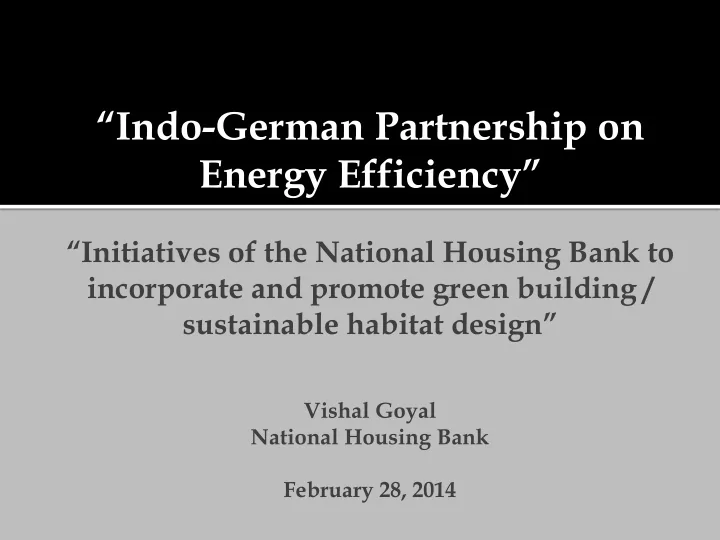

“Indo -German Partnership on Energy Efficiency” “Initiatives of the National Housing Bank to incorporate and promote green building / sustainable habitat design” Vishal Goyal National Housing Bank February 28, 2014
Projected Timeline Demographic Changes By 2050 World’s population will reach 9 Billion By 2050 70% of the world’s population will live in urban areas, up from 50% today By 2030 40.8% of India’s population will be living in urban areas (current 28.4%), increasing to 50% by 2041 Housing sector accounts for nearly 40% of energy consumption Populations in emerging markets are creating a huge demand for homes that need to be both affordable and green
Energy efficient housing balances all aspects of energy use in a building Lighting Space utilization Ventilation Use of energy efficient building materials Use of energy efficient equipment Use of alternative and renewable sources of energy Reducing energy demand at source More sustainable in long run Often with little incremental cost
National Urban Housing & Habitat Policy (NUHHP) 2007 Appropriate ecological standards for healthy environment and better quality of life. Implementing the concept of ‘green’ and ‘intelligent’ buildings. “Strong recognition of financial sector’s crucial role in integrating climate considerations and sustainability into their operations”
Statutory body National Housing Bank Act, 1987 Regulator of Housing Finance Companies in India Promotion and development of housing and housing finance sector Financing provided to Primary Lending Institutions for retail housing finance
Equity Refinance Direct Finance Participation Term Loans Term Loans Equity stake Commercial Banks Housing Rural HFCs Housing HFCs involved in Finance Corporations Societies Companies (HFCs) housing finance to Cooperatives PPPs low income Self Help Groups segments for General Housing Rural Housing Special projects (in natural disaster affected areas)
Important step forward in promoting use of energy efficiency techniques in buildings Programme initiated jointly by NHB and KfW, German Development Bank in 2008 pursuant to Indo - German Government-to-Government negotiations Prime objective of the Programme – Promoting Energy Efficient Residential Housing First of its kind of programme in India
Line of Credit of € 50 million on 31st Dec’ 2010. Technical assistance grant of € 1.5 million. The Programme Financial and technical assistance to stakeholders to promote EE residential housing Financial assistance - housing loans to individual borrowers through retail lending institutions for purchase / construction of EE residential houses / flats Technical assistance – Fraunhofer TERI Assessment Tool to calculate the level of energy savings of EE houses on the baseline (developed by TERI / Fraunhofer)
Initial implementation - facilitator appointed to assist NHB Identification of EE building projects Identification of retail lending institutions Assessment of refinance potential for NHB Gathering of borrower information Assistance in energy calculation & certification Compliance with NHB’s reporting requirements to KfW Launching of logo and website for the programme – ee- homes.com Signed MoU with IGBC and AdARSH
Program Structure and Flow
NHB has utilised the entire sanctioned amount of € 50 million i.e. equivalent to INR 381.53 crore 12 Projects comprising of 162 towers have been certified in the cities of Lucknow, Nagpur, Mumbai, Bangalore and NCR 2065 individual loans have been refinanced by NHB LICHFL, Axis Bank, ICICI Bank, HDFC, DHFL, and Tata Capital have availed Refinance from NHB under the Programme Full time TA consultant appointed to assist NHB in programme implementation
NHB issues certificate to the Developer
Reduction in energy usage without compromise on comfort Building of sustainable housing and habitat to positively impact society and environment Availability of funds - source for encouragement Lenders Borrowers Availability of assessment tool - help to developers
Lack of awareness Perception Energy efficiency is expensive requiring huge upfront investments Marketing gimmick of developers High maintenance cost Lack of awareness and information about Government schemes promoting use of solar energy, etc.
Next Steps Absorption capacity / consumption of EE products / market for EE residential housing in India to be enhanced / encouraged Scalability important due to challenges Cost aspects Huge housing shortage Existing housing Present product for niche market segments Programme to be expanded to include existing housing units
To Summarize Energy efficiency - priority area for Government and policy makers NHB-KfW partnership - new initiative with huge scope Finance - an important tool for promoting energy efficiency in buildings Scalability - an important factor Multi-pronged approach to overcome barriers
Sahara City Homes Nagpur Savings – 26% Number of Units – 2,646
BCIL ZED Collective, Bangalore Savings – 40% Number of Units - 44 NHB-KfW:EE Homes
BCIL ZED Woods, Bangalore Savings – 33% Number of Units-60 NHB-KfW:EE Homes
Lotus Panache, Noida 3C Projects Savings – 21% Number of Units – 4,048 Lotus Boulevard, Noida Savings – 20% Number of Units – 2,224 NHB-KfW:EE Homes
HIRCO, Mumbai Savings – 34% Number of Units – 1,212 NHB-KfW:EE Homes
Recommend
More recommend